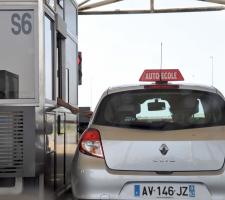
Toll evaders create major problems for tolling companies – of which lost revenue is only one.
Toll road operators are increasingly employing open road or free-flow electronic tolling to minimise travel times. That’s great for regular account-holding drivers but knowing there are no toll collect booths can tempt other time-strapped motorists to turn off congested free-use roads onto fee-paying lanes. In regions like Greece and South Africa there has been mass refusal by drivers to pay the tolls. Such incidents, while exceptional, highlight a key decision for all toll operators; when and how should violators be pursued?
Statistically violators account for up to 8% of traffic on electronically tolled roads with more than 70% of the violating motorists being identifiable through the department of motor vehicle (DMV). Therefore an authority may have tens of thousands of violators every day, creating a major loss of revenue and leading many to classify this as ‘stealing’.
Violation enforcement is especially important with variable/congestion pricing models as non-paying drivers undermine the travel time calculations upon which the variable toll structure is based. Surveys of toll users show they expect toll agencies to pursue all collection remedies and keep tolled lanes for the exclusive use of paying customers.
Pursuing non-paying motorists imposes a heavy workload on an agency’s staff - but in reality there is no option. Failure to pursue non-paying users would compromise the toll concept, weaken the authority’s business case and upset both their registered users and investors.
At the same time, toll operators must maximise and maintain public support which would be badly damaged by rushing first-time violators to court after they inadvertently took a wrong turn.
According to Richard Carrier, SVP and managing director of Pennsylvania-based collection agency
He cites evaders who try to obscure their license plates or who establish an account and allow it to fall to a negative balance while continuing to use the toll road and ignoring account revocation notices. The problem is further complicated as approximately 8% ‘forget’ to notify the tolling agency or the DMV of changes of address (known as ‘skips’), resulting in notices being returned as undeliverable.
“A small percentage of violators, referred to as habitual offenders, wait to see if the agency can identify and locate them and to what extent, and to what cost, it will pursue the amount owed,” he said.
The tolling authority’s options will be governed by the legislation country or state so there is no ‘universal’ solution.
“Particular problems can arise in the move to all electronic tolling as the operator must adapt its enforcement policies and may find the legislative requirements to be longer and more complicated than anticipated,” said Carrier.
“An effective toll-invoicing and violation collection program has to be based on the agency’s business rules which must detail the enforcement measures the agency will employ. To avoid legal challenges, business rules relating to enforcement procedures and penalties for non-payment must comply with local laws, be incorporated into the user agreement and be prominently displayed on the agency’s website,” he adds.
A coordinated public relations outreach program (via all media outlets) is essential to inform drivers of the impending opening of (or changes to) a tolled roadway and the consequences of evading the tolls must also be made clear.
Clear signage and road markings must indicate the toll lanes’ entry and exit points to prevent motorists from inadvertently entering the tolled sections and a short ‘foregiveness’ period will allow motorists to adapt to any new tolling scheme.
Various user-friendly options will encourage new accounts sign-up and tolls must be easily payable via the web and mobile phone or at local businesses and the customer service centre. An effective customer service plan should be in place with an emphasis on incentivising drivers to become account holders.
Nevertheless, between 10% and 35% of drivers will choose to be ‘Video Patrons’, where their plate is photographed when they use the toll road, their name secured from the appropriate DMV and an invoice sent. Processing ‘pay-by-plate’ transactions is estimated to cost approximately $1.95 which is typically passed on to the motorist in higher tolls.
The accurate identification of license plates is the basis of any toll enforcement system. Carrier: “The number of video toll transactions increases with all electronic toll roads and the integrity of the collection process depends on proper motorist identification. Misidentified motorists create additional work and may result in bad press for the agency.”
So when should violators be pursued? For the first offence, or when repeated, and should motorists be notified immediately or given a period of grace?
State laws typically require first notices be sent within 14 and 30 days from the date of the toll transaction to notify the patron/violator.
Carrier advises early action: “Best practice dictates sending the first notice within the shortest period of time, when the toll trip is in the motorist’s recent memory. Early notification shows users that they are being tracked by an effective enforcement system.”
All notices should outline all enforcement and related penalties, offer ways to open an account and receive the discounted electronic toll collection (ETC) rate. Notices should also include a method to contest the violations or to transfer liability to the responsible party.
After internal billing and collection processes, the toll agency must then decide how to deal with the remaining unpaid violations.
Even with participation in state-sponsored enforcement programs such as DMV Registration Hold or Suspension and Tax Refund Intercept, a significant amount of revenue remains uncollected.
“It is amazing how many people ignore notices and attempt to elude even state sponsored enforcement programs designed for toll operations,” he said.
Many tolling companies employ professional collection agencies with the expertise and advanced systems to pursue violators - be they in-state, out-of-state or out-of-country. Best practice is for violations to be assigned to collection agencies between 90 and 120 days after the initial invoice or violation notifications have been ignored. At this point the collection emphasis shifts to the more legalistic methods of toll-violation enforcement.
Professional collection agencies usually work on a contingency fee basis and employ skip tracing techniques to locate violators at a current address. “If you start off with a typical 8% ‘return to sender’ rate, half of those will be traceable, the majority of traced violators will respond to the payment demands,” said Carrier, adding: “Collection agencies often help resolve the patron’s account problems which caused their tolls to become violations. In a typical revoked account scenario, the patron assumes the agency’s customer service centre will fix their problem and thus ignores the violation notices.”
In many countries the debt recovery procedures set out in national/state legislation will require unpaid toll violations to be dealt with by county courts, where cases can get lost in the morass of low-level misdemeanours.
When dunning and outbound calling fails to work, taking violators to court, if allowed by statute, is a highly effective means to collect. But Carrier sounds a note of caution: “Before taking a violator to court, both the tolling authority and debt collection agency must ensure all other avenues have been explored and the evidence is incontrovertible. “If the court decides in favour of the driver, it will not only cost the tolling authority money but also credibility, and the outcome may be picked up by local news agencies, making continued toll evasion even more likely.”
For tolling enforcement he cites California’s statutory structure as the most effective because it allows for noticing with escalating penalties for repeat offenders, an informal and formal review process for disputes, and an effective civil judgment process.
It seems the best toll enforcement policies persuade drivers that the toll represents good value and encourages them to open an account because the toll costs are insignificant compared with the fines incurred by violators.















